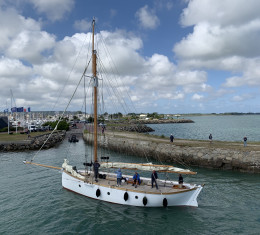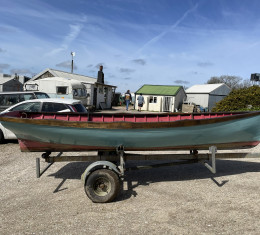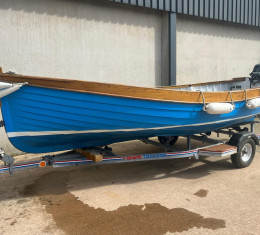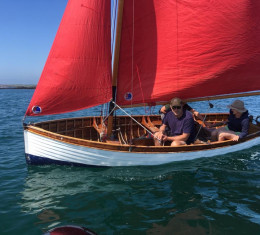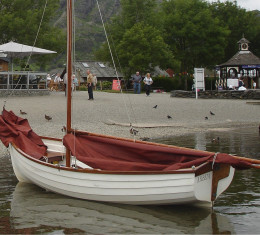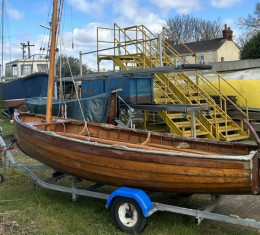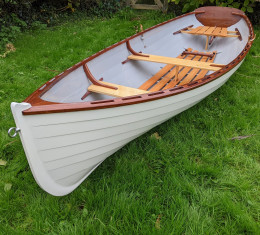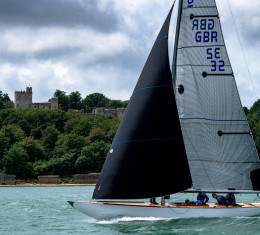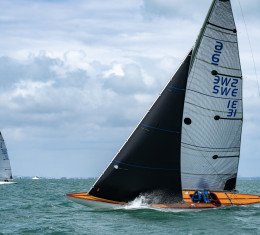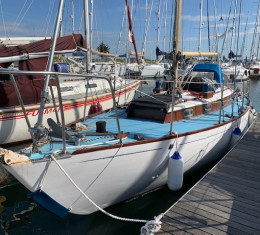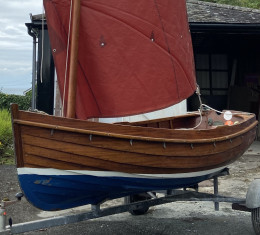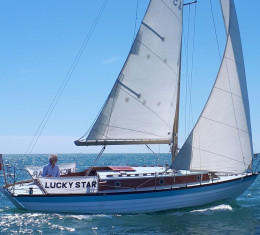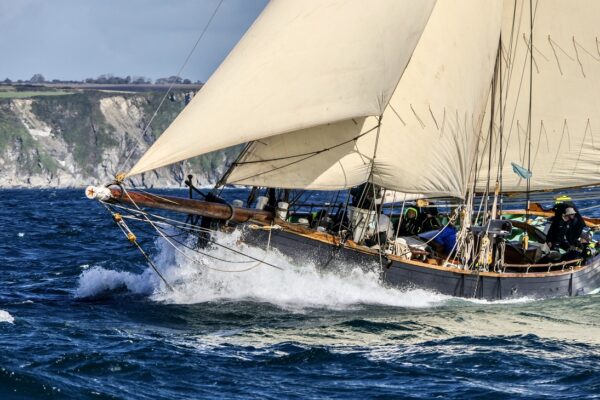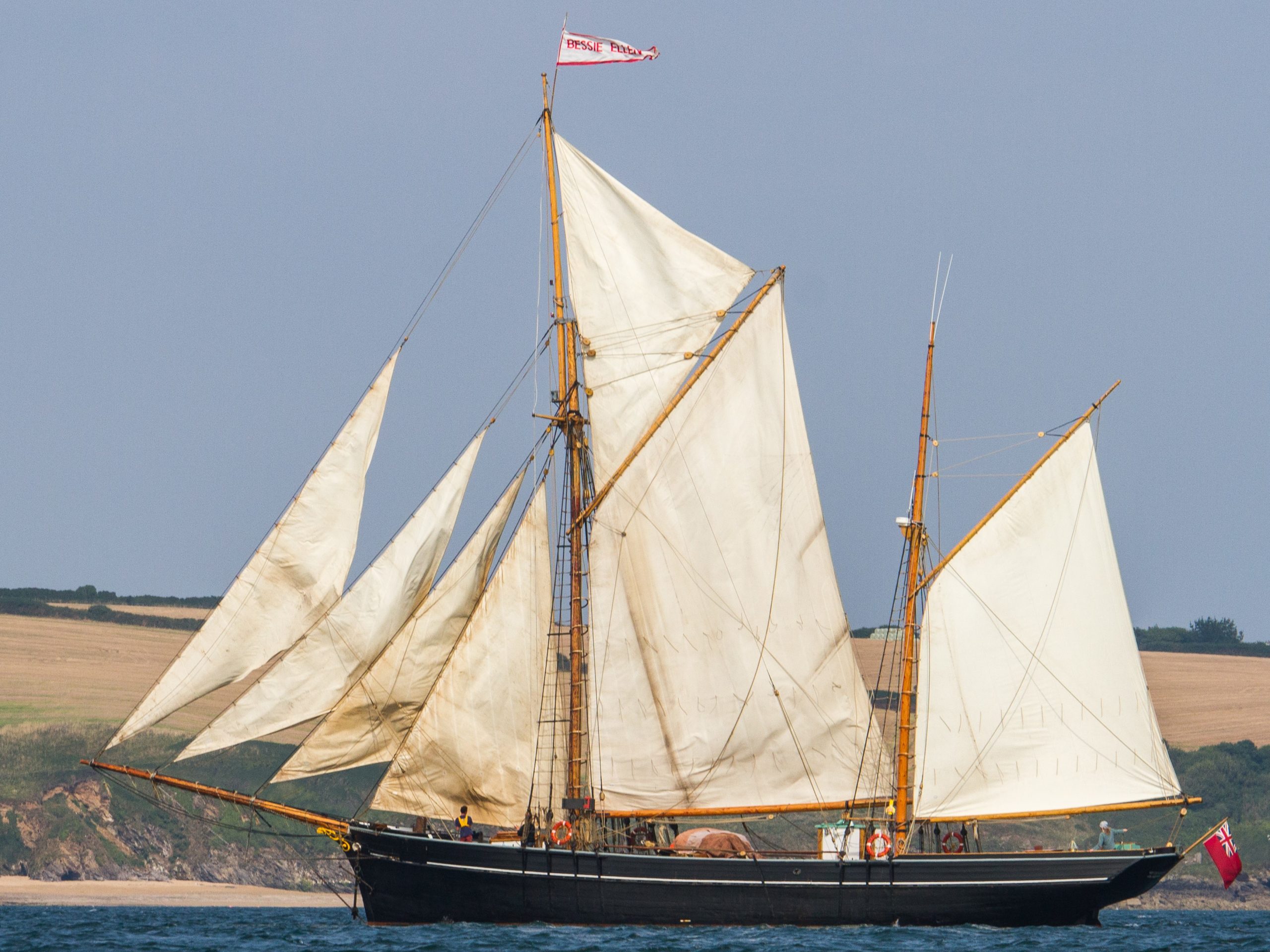
Sailing on the Gaff Ketch Bessie Ellen
Bessie Ellen is a Westcountry trading ketch, built in Plymouth in 1904 and is very typical of the type of boats that were being built in great numbers around the coast throughout the 19th an d early 20th century. After a lifetime of carrying cargo she now operates as a charter vessel with her owner Nikki Alford who rebuilt the boat from a bare hull.
I join the ship now and then to skipper for Nikki and I came aboard to help bring the boat back from the Canary Islands after her winter of chartering in the sun.
This is a log of our voyage from Tenerife to Lisbon.
9th February 2013.
Last minute preparations underway before departure. Bobstay, whisker stays and forestays are all tensioned, food is loaded and stowed away and passage plans are logged with MRC in Falmouth and Portugal. The list of jobs needing to be done on any boat before setting off on an extended ocean passage is endless, but special attention has to be paid on this type of vessel that has just finished a long hard charter season. We did a full rig check from top to bottom looking for any tiny stress fractures in the iron work, chaffing in the running rigging and other damage that could become a problem at sea. The boat is in very good condition and looks extremely smart thanks to the hard work, time, effort and money put in by her owner so we don’t have too much to worry about on that side of things.
The guests arrive in the afternoon, and once they have been taken through the safety talk and a briefing about shipboard life while at sea, we slip lines and head round the coast and drop anchor off Los Christianos. From here it is easy to weigh anchor and head straight off without hassle, and it is nice for the guests to spend a first night on the boat out of the marina but not at sea so they can get used to their new surroundings and find their way around the ship. We have a superb big hearty meal of roast pork followed by homemade lemon cheese cake followed by a good nights sleep.
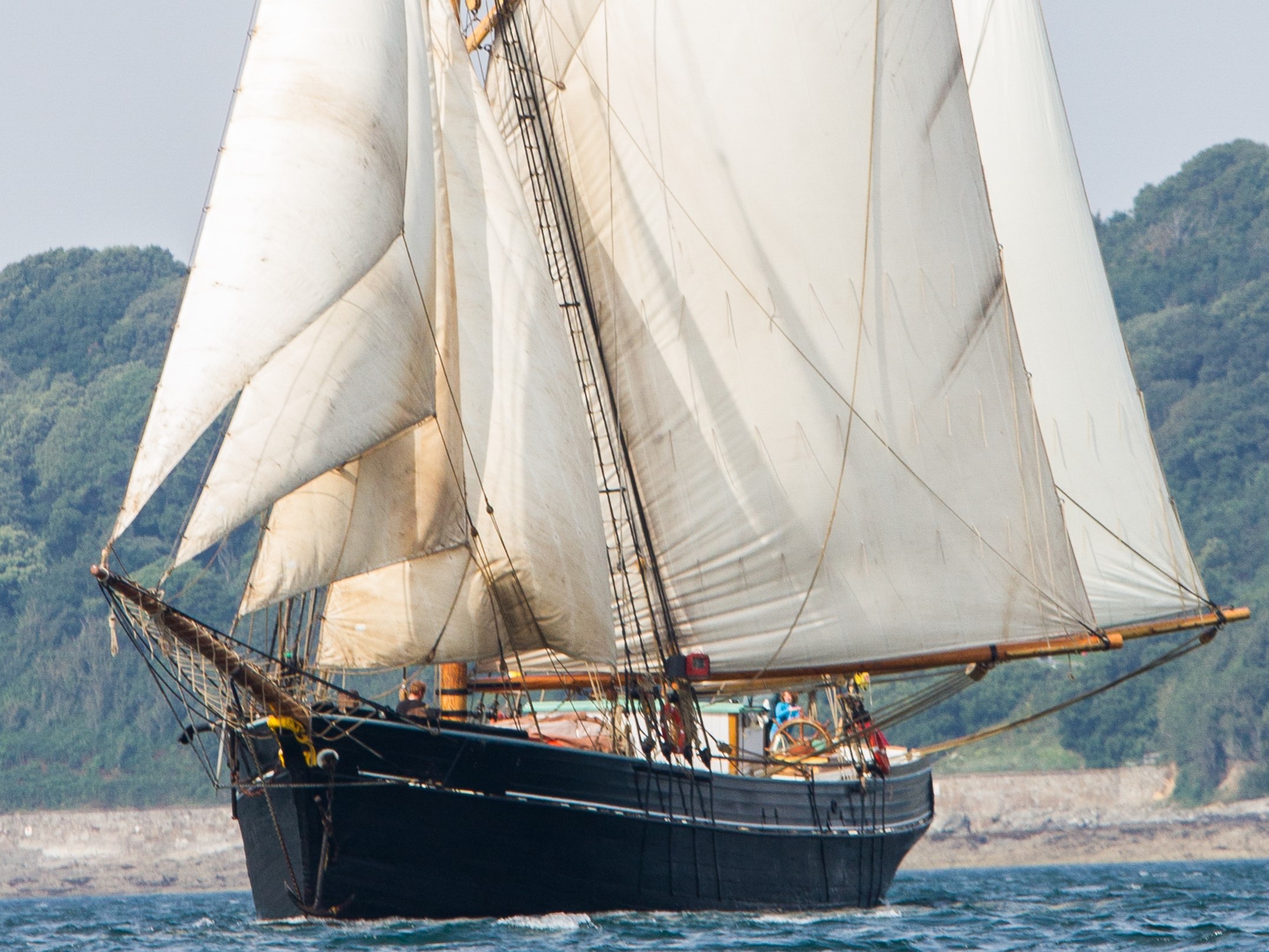
The Bessie Ellen – 1904 West Country Trading Ketch
10th February 2013.
Noon position: 28ᵒ16.3’N 016ᵒ55.7’W
Forecast: NE F5/6. Moderate to rough sea conditions. Plan is to head NNW, pointing as much as we can but keeping boat speed up until we are north of Madeira where we will be able to take advantage of the Azores blocking high pressure and start heading east.
0830. Weigh anchor. There is very little wind on this western coast of Tenerife in these north easterlies so we motor up the coast in mirror calm waters. We kill the engine and drift near a pod of pilot whales, several of which swim right up to the boat and dive under our keel.
1200. The Canaries is well known for its acceleration zones where the wind is funneled between the islands and can easily be 15 knots more than forecast. With this in mind we set the main with a single reef followed by the staysail, inner and outer headsails.
1300. Course 315*M. Sail out of the lee of the land into rough seas and strong winds which quickly build to 40-45 knots with frequent gusts of 55 knots. It seems the reef was prudent. The ship takes it well making 8/9 knots boat speed on a fine to beam reach.
1600. Course 340ᵒM. Winds ease to a steady 30-35knots and we settle into a comfortable rhythm on a course of 340 M. watch system temporarily altered to 2 watches so as to strengthen the crew in what is forecast to be a lively night. Tomorrow we will return to a 3 watch system as planned.
2000. 340ᵒM. Choppy confused seas that we encountered around the islands are dissipating and a more consistent 2m ocean swell is coming through. The ship has settled into a steady motion with the occasional larger wave making her roll uncomfortably. The helm is light and easy and the new guests are quickly getting the hang of helming an 85ft ship. Some of them are used to sailing small modern yachts with tiller steering so it take a little coaching and some practice to get them steering a steady course. The off watch clear up after dinner which was served straight from the galley in these rolling seas.
11th February 2013.
Noon position: 30ᵒ05.68’N 018ᵒ25.93’W.
Days run: 137Nm.
0800. 340ᵒM. My watch take the deck. The NE wind have settled in now with a steady Force 6 breeze giving us about 6 knots. There’s bacon for breakfast!
1200. 340ᵒM. At the change of watch we shake out the first reef in the main. The wind is steady Force 6-7 so she will happily take a full mainsail.
1730. 345ᵒM. A loud bang reverberates through the hull. Shouts from the watch to get on deck. We have snapped a link at the bottom end of the bobstay leaving the bowsprit dangerously unsupported. We drop the inner and outer jib and heave too where we can assess the situation. Our options are to motor sail north to Maderia but that is straight into the choppy seas. We decide on a running repair at sea. The bottle screw at the top end of the bobstay is let go with the chain held on a rope. We lower one of the crew down on the inner jib halyard wearing a drysuit. He very cleverly manages to join the two parts of the broken chain with a big shackle and gets a cable tie on to seize it. We then attach a chain hoist between the top end of the bobstay chain and the bowsprit and winch the two parts together until we can do the bottle screw up and eventually tighten the chain. An hour later we are as good as new, except for the several bits of rope attached to the bottom end of the bobstay which will have to wait until we reach Lisbon.
1900. 335ᵒM. Just getting dark and we are back underway. The crew are getting changed out of wet clothes when there is a shout from the helmsman. The clew of the mainsail has pulled out and the main is flogging in the breeze. It never rains but it pours! We quickly lower the peak and throat halyards, run out the reefing tackle and haul in on the second reef. There is no chance we can get the 1st reef as that pennant is taking the whole strain of the sail. 15 minutes later the main is set nicely with 2 reefs. The easy repair can wait until daylight tomorrow.
2300. 340ᵒM. Engine on. Decide to motor sail as wind is decreasing. Sheet in on the main and attach preventers to the boom and gaff to stop them crashing and causing anymore damage.
12th February 2013.
Noon position: 32ᵒ03.61’N 019ᵒ04.19’W.
Days run: 125Nm.
0800. 004ᵒM. Wind is veering as promised and is now ENE. Making 6 knots motor sailing. First few spits of rain, we must be heading north!
1400. 000ᵒM. The mainsail clew has been repaired so we reset the lashing, shake out the reef and set the full main. Outer jib hoisted and engine off. The wind has shifted to ENE so we are now sailing due north.
13th February 2013.
Noon position: 34ᵒ02.7’N 019ᵒ10.7’W.
Days Run: 131Nm
0700. 005ᵒM. Spotted first vessel since we left Tenerife. As the sun rises we can see it is an oil tanker. He does not come up on the AIS for some reason even though he is only 7.2 miles so we are not sure what the name is where it is heading.
1300. 017ᵒM. Making good ground now with the veering wind, even managing to make some easting which we desperately need to do. Looks from the forecast as if the winds are going to die off as we head north from here. Lunch on deck of pumpkin soup and homemade crusty bread, we eat like kings on this ship!
14th February 2013
Noon Position: 35ᵒ50.8’N 018ᵒ53.7’W
Days run: 117Nm
0500. 025ᵒM. Wind is veering significantly now, just what we need so we can alter our course towards Lisbon. Another ship sighted, M/V Primrose bound for Boston. Call him on the VHF as we can’t see him on AIS. He reports that he can’t see us either indicating a problem with our AIS transceiver. Spend some time going through the manuals but to no avail, everything seems to be fine except that it doesn’t work! We will have to wait until there are more ships around so it can be tested properly as there is little traffic out here to pick up anyway.
1300. 395ᵒM. Busy morning with shifting winds. Headsails have been hoisted and dropped several times and the main sheeted in and out to account for the wind which is backing and veering and going from force 2 to 5 every half hour, keeps the watches busy.
1500. 060ᵒM. Wind has come right round enabling us to lay a course for Lisbon, although we are moor sailing. The winds are a light 10 knots, enough to fill the sails and steady our motion but not enough to give us any speed. We are after all working to a deadline as we have guests who need to catch flights. We take advantage of the easy rolling ocean swell to get up the mast and fix the red all round sailing light which has most likely blown a bulb. There is enough wind in the sails to stop the roll which is horrible while trying to work aloft. I don a harness, fasten it to the gantlin and climb the ratlins to the hounds, from where I will clamber, half hoisted, to the lower part of the topmast where the red and green all round sailing lights are located. It turns out it is the bulb so fortunately a quick fix. Fantastic view of nothing but gentle ocean swell from up here.
1600. 035ᵒM. Winds backed again. We sight a whale blow about half a mile on our starboard beam so we put the helm down and make our way slowly over. After 10 minutes of waiting the whale surfaces again and it turns out it is not one but two, possibly Fin Whales. They send enormous blows of spray from their blowholes before diving again. As we motor slowly away one of them breaches, jumping half out of the water, it is certainly a big beast!
2000. 060ᵒM. Motor sailing into the night with main and main topsail up and the staysail, 750rpm on the engine giving us 6.5kts. Plan is to carry this course NE until we are on a similar latitude to Lisbon, by which time it is forecast to blow a steady F5 SW which will carry us on a starboard tack broad reach all the way into the coast. Plans can always be changed!
15th February 2013.
Noon position: 37ᵒ26.91 016ᵒ46.66’W
Days run: 148Nm
0800. 060ᵒM. Peaceful night aboard. Wake up for my morning watch to find the Atlantic is a mill pond. Just shows you never know what to expect out here at this time of year, it could just as easily be a gale. We see some flying fish for the first time since leaving the Canaries, they are really bizarre animals!
1100. 060ᵒM. Wind is filling in from the SE so we can lay a straight course for Lisbon. We set the headsails and sheet out the main. Not enough wind to sail yet so we leave the engine on but reduce the rpm. We are still working to a bit of a deadline so can’t afford to drop the speed right down. We are now making 7.5kts, if we can keep this for 24hrs it will take the pressure of and we can sail at a more leisurely pace. Passage making with deadlines to meet is not ideal as it can sometimes force decisions to be made but the boat is a business and has to be run to a schedule, although not at any cost. If the weather became really adverse we would of course seek shelter and find other ways of getting our guests to their flights next week. The crew on my watch are set to work, the deadeyes have to be oiled with linseed, rust stains removed and the manual deck bilge pump is being wire brushed ready for a fresh coat of tar. There are constant little jobs to do aboard a boat on passage, last night the steaming light bulb blew so I will pop up the mast and replace that this morning. The 240volt impellor pump we use as a daily bilge pump and for empting tanks was starting to struggle, a quick inspection found the impellor was missing a blade or two so it was replaced. A 5 minute job but it could be crucial in an emergency if the bilge doesn’t perform to its optimum.
2000. 075ᵒM. We decide to bring the main topsail down at the change of watch. Forecast is not entirely clear and it could blow a bit so better safe than sorry.
16th February 2013.
Noon Position: 38ᵒ17.62’N 14ᵒ00.15’W
Days run: 143Nm
0400. 085ᵒM. We have the 4-8am watch today which I like as you get to see the sunrise and finish with a good breakfast. We are still motor sailing but the wind has veered to SSW and is slowly building. It appears from the forecast we are going to get a sou’ westerly blow before we make landfall and this is likely the start of it. Barometer has started to fall.
0800. 085ᵒM. Wind has built sufficiently so we can sail and still make good speed, we set the flying jib and within an hour are making 6.5kts in the freshening breeze. Breakfast of champions today – freshly baked bread and leftover plum tart from dinner last night!
1200. 085ᵒM. Wind is a steady F5 on the beam and we are making an effortless 7-7.5kts. It is times like these you can tell that Bessie Ellen was designed as a sailing ship with no engine, in the right conditions she glides along with such a comfortable motion and so easy on the helm, it really is a joy to take the wheel.
1400. 085ᵒM. The ‘Bessie Ellen Bake Off’ reaches its third day. It is the turn of my watch today to bake the cake for afternoon tea, in competition with the middle and starboard watch. As watch leader I do as any leader does and delegate the task to someone who actually knows what they are doing! We get a superb lemon drizzle cake, and although I’m bias, I think it is the clear winner. We also take this opportunity to do a sweepstake for our time of arrival, closest to the mark wins a bottle of rum so people are studying the log book hard to make their best guesstimate. Wind has slacked a little but the clouds look ominous so we decide that a reef will be taken in before dark, perhaps over cautious but prudent none the less. Handling a big gaff main in the dark with rolling seas is no fun when the wind gets up, and the old girl doesn’t deserve to be stressed too much at the grand old age of 109.
1700. 085ᵒM. Take the first reef in the main. Good practice for the guests to do this kind of sail handling in adverse conditions, keeps them on their toes!
2300. 090ᵒM. Wind eventually building from the south. Gusts now of 30 knots with an increasing sea, but it’s on the beam and she is taking it well. Making a steady 7 knots boat speed.
16th February 2013.
Noon Position: 38ᵒ 41.93’N 010ᵒ 42.12’W
Days run: 158Nm
0400. 095ᵒM. Take in the outer jib as the winds reach a steady F6-7. We are sailing fast but comfortably. It’s a bit lumpy down below but everyone is managing to get some sleep of some description. The rain squalls are coming thick and fast, this is the first night I have to get out the waterproof trousers, I guess they are here for the duration now.
0800. 095ᵒM. Bacon and baked beans for breakfast! We now have less than 100Nm to go and it looks like we might make it in tonight before last orders at this speed.
1200. 095ᵒM. Fastest day yet with a very satisfactory 158Nm from noon to noon, and all under sail. Put a good breeze on her beam and she will really fly!
1300. 095ᵒM. Wind is veering again to due West and dying rapidly. We are quickly left with a lumpy sea and not enough wind to fill the sails. We try sheeting the main in hard and putting a boom and the two gaff preventers on but the gaff yard is still crashing horribly so we do a quick drop and get it all lashed down tight. The next few hours we will no doubt be rolling around but at least we won’t break anything. It’s engine for the last miles of the trip unfortunately.
1600. 095ᵒM. Cross the Portugal VTS reporting line. We call ROCA Control to inform them of our inbound passage to Portugal, give our present position, course and speed with ETA in Cascais. We are now crossing the southern side of the Cape Roca TSS (Traffic Separation Scheme) so we will be seeing a lot more ships travelling north and south, time for the watches to keep their eyes peeled.
2000. 105ᵒM. The TSS is not as busy as we expected. Picked up the lighthouses of Cabo Roca and Cabo Rosa.
2300. Tied up and all secure in Marina de Cascais. The guests are tired but extremely happy. We open a couple of bottles of red and toast ourselves and the ship, as always she has done us proud this trip.
Find out more about how to come sailing on Bessie Ellen.

